How To Do The Push-Up Properly
Learn how to push it, push it real good, and build up your pecs
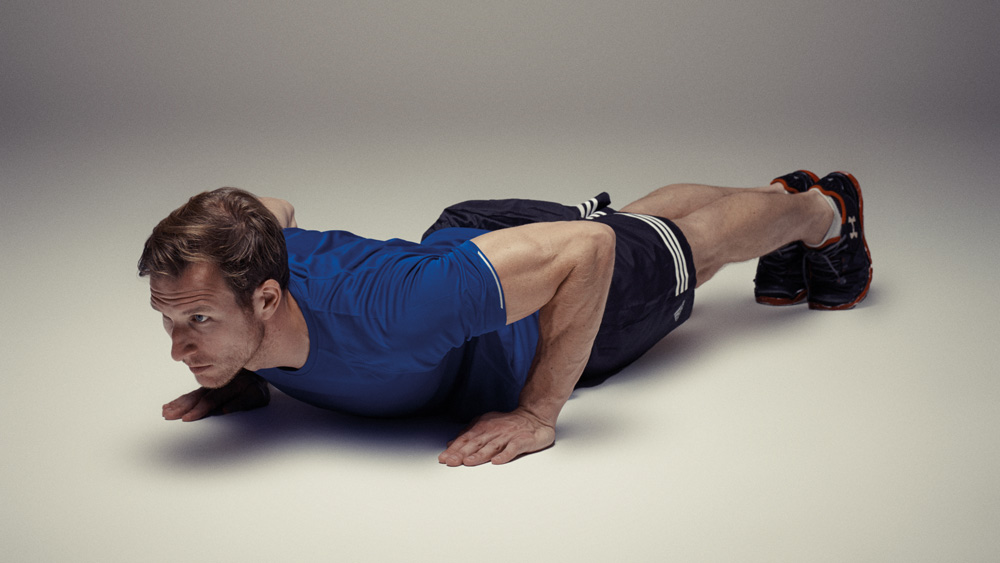
The push-up is often overlooked and considered unworthy of inclusion in many upper-body workouts. That’s a big mistake. Because when it comes to building a bigger and stronger chest, few moves are better than the classic bodyweight exercise that’s still used to separate the army men from the army boys.
This effective chest builder can be done anywhere, any time—and it works your shoulders, triceps and abs too. And there are a number of great variations that mean you’ll never run out of simple moves that sculpt impressive pecs.
Former Royal Marine physical training instructor Sean Lerwill details—and demonstrates—his favourite push-up variations, as well as his performance and progress tips so you can build a bigger and stronger upper body.
We also have essential form tips from the PT who trains other PTs, Alasdair Nicoll.
How To Do The Push-Up
- Start with your hands underneath your shoulders and toes on the floor.
- Brace your core and raise your hips so your body forms a straight line from head to heels.
- Keeping your weight on your arms, bend your elbows to lower your chest towards the floor. Don’t let your hips sag or rise during the set: if they sag, it puts pressure on your back; if they rise, it takes the tension off your chest.
- Pause briefly at the bottom, with your chest as close to the floor as possible without touching it.
- Press back up powerfully to return to the start.
Tempo
“Far too many people think the push-up is an exercise that is beneath them—they favor barbell bench presses, dumbbell flyes, cable crossovers and other weighted moves to build up their chests instead,” says Lerwill. “But the push-up is a tried-and-tested upper-body muscle builder, and the beauty of it is it can be done any time. To get the gains you want, don’t rush your reps—taking your time to lower and lift your torso. Try a 4010 tempo—a four-second lowering phase, no pause at the bottom, a one-second pressing phase, then no pause at the top—to get your muscles better at controlling each movement. Or try a 3110 tempo that introduces a one-second pause at the bottom of each rep—all of a sudden this ‘easy’ and ‘boring’ bodyweight exercise is a legitimate muscle-building move.”
Push-Up Form Tips
For advice on how to nail a perfect press-up, we spoke to Alasdair Nicoll, personal trainer and tutor at The Fitness Group, which provides personal training courses.
1. Make Sure You Have A Stable Starting Position
“For most people, the hand position should be one-hand width outside of their shoulders,” says Nicoll. “Make sure that your wrist is directly underneath your elbow and your shoulder. The phrase we use is stacking joints. If you stack the shoulder and the elbow and the wrist on top of each other, it creates a really stable base from which to start the movement.
Get the Coach Newsletter
Sign up for workout ideas, training advice, reviews of the latest gear and more.
“Your feet should be pretty much in alignment with your shoulders, again to create as much stability as you can, because the more stability that you’ve got in any exercise, the more force production you can have and the greater level of muscle recruitment you can utilize in the exercise.”
2. Form An Arrow With Your Elbows
“You want to make sure that the direction in which the elbows are traveling is right,” says Nicoll. “You don't want them traveling out to the side because that’s going to put unnecessary stress through the shoulder.
“If we were to look over the top of the person, we’d want to see an arrow shape from the head down to both elbows. They should be angling back at pretty much a 45° angle. That would be optimal for prioritizing the chest, and will also help to get a full range of motion through the chest.”
3. Get The Tempo Right
“Make sure that when you go through the motion of the push-up that it's under full control,” says Nicoll. “Not just dropping into the movement, but doing it under control, potentially using a tempo. That could be two to three seconds on the way down, then a slight pause for a half second at the bottom. Then on the way up, making sure that that movement is really intentful. It should probably be close to a second for the powerful concentric part of the exercise.”
Push-Up Workouts
The classic push-up is a great exercise for improving muscular endurance in your pecs, front shoulders and triceps, as well as a fantastic way to work these muscles to full failure to encourage muscle size growth. To do this, perform a set of push-ups to failure after every set of bench presses. So once you finish your set of eight to 10 bench press reps, immediately move to the floor and do a set of push-ups to failure, which means you literally cannot do one more single rep with good form. This will work all those muscle fibers in your chest that don’t get worked by your heavy bench presses so you’ll build more muscle size, strength and endurance.
Push-Up Variations
Diamond Push-Up
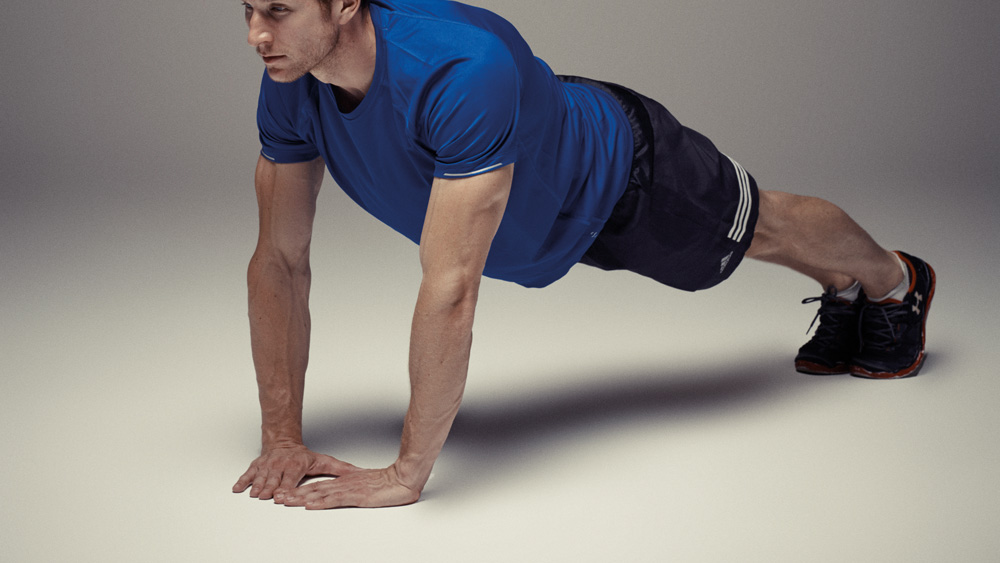
Want bigger arms? The diamond push-up is the move for you, because this variation places far greater emphasis on your triceps than your chest to pack on size on your upper arms. To make the most of this move, focus on squeezing your triceps at the top of each rep, and think about how your triceps are contracting when you lower your torso towards the floor, using a good slow and controlled tempo. The more you can focus on a muscle moving during an exercise, the greater the rewards.
- Start in the push-up position but with your hands together so that your thumbs and index fingers form a diamond.
- Brace your core and raise your hips so your body forms a straight line from head to heels.
- Keeping your weight on your arms, bend your elbows to lower your chest towards the floor. Make sure your elbows point back, rather than out to the sides, during the lowering phase of a rep to avoid over-stressing the joint.
- Pause briefly at the bottom.
- Press back up powerfully to return to the start.
“This move is a lot harder than it looks, and that means a lot of people give up quickly because they can’t do many full-range reps,” says Lerwill. “To get stronger so you can do more reps, just do the lowering part of the move, keeping the tempo slow to make your muscles work harder, then kneel back up to return to the start. Alternatively lower yourself in the diamond position, then take your hands back to normal width to push back to the start.”
Wide-Arm Push-Up
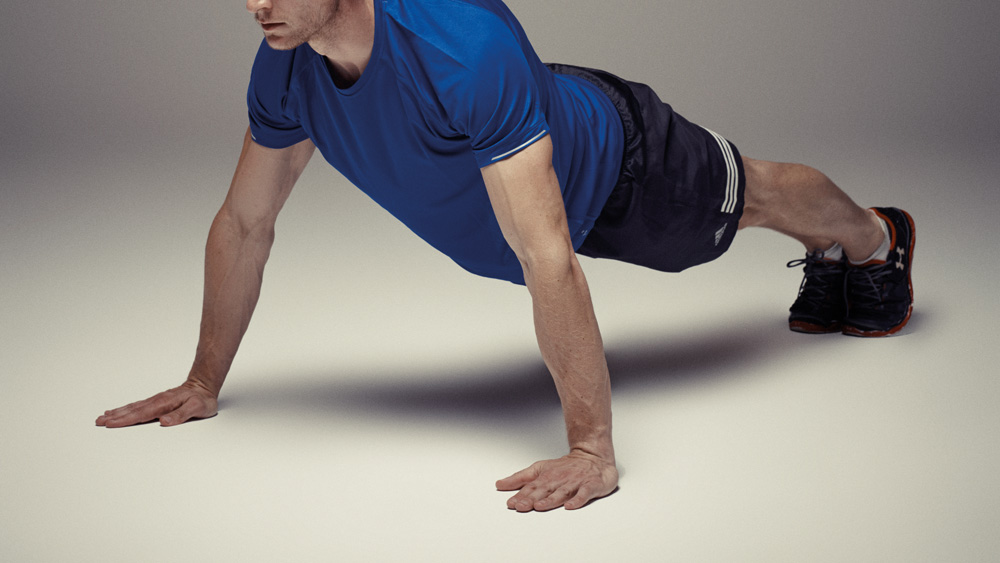
Placing your hands wider apart increases the focus on your chest and lessens the involvement of the triceps and shoulders. It’s important to perform the move safely by lowering your torso to the ground slowly and under full control—doing so will both reduce the risk of injury and increase the effectiveness of the move. You want to feel a good stretch across your chest as you move closer to the ground. The quality of the rep is always more important than the width of your arm position – don’t sacrifice form by placing your hands too far apart.
- Start in the push-up position but with your hands about double shoulder-width apart.
- Brace your core and raise your hips so your body forms a straight line from head to heels.
- Keeping your weight on your arms, bend your elbows to lower your chest towards the floor.
- Pause briefly at the bottom, with your chest as close to the floor as possible without touching it.
- Press back up powerfully to return to the start.
“You need to ensure that your head and neck stay tight and in line,” says Lerwill. “Allowing your head to hang can cause your shoulders and upper back to round, which is poor form and makes the move less effective. This often happens as you get close to failure, so instead of going until you can’t do another single rep, stop once you notice your form suffering, rest on your knees for a count of 10, then do another set of reps. When you hit failure a second time, rest again, then do one final set to build chest strength without risking injury.”
Side-To-Side Push-Up
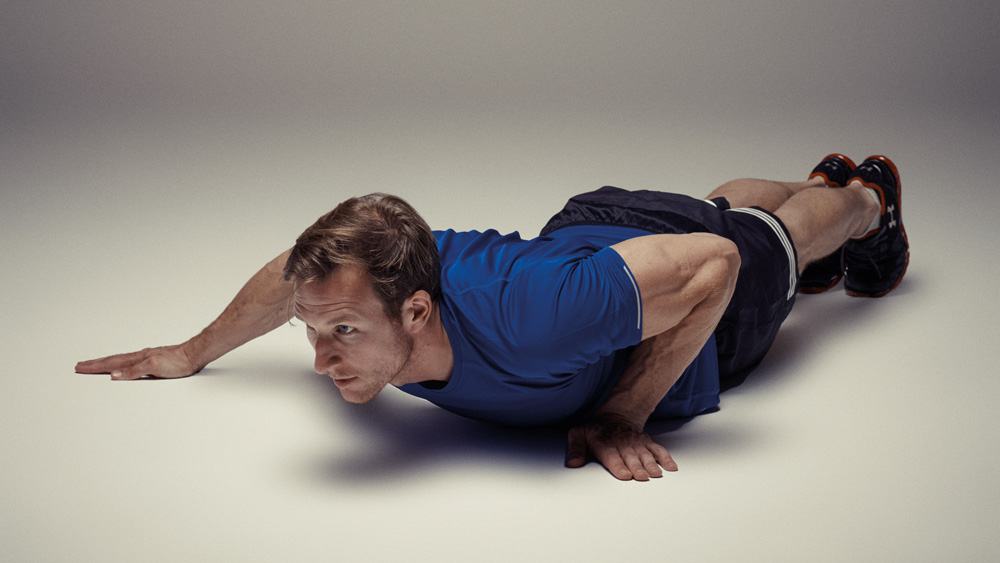
This variation is a great way of increasing the difficulty of the basic move to make the muscles of your chest, shoulders and triceps work hard to support, manage and move your bodyweight up and down and from left to right, while your core muscles need to be fully engaged to keep your torso level for the duration of each rep. The deeper you go each rep, the more effective it will be. That does make it harder so if you’re struggling, reduce the rep count and focus on quality of movement.
- Start with your hands underneath your shoulders and toes on the floor.
- Brace your core and raise your hips so your body forms a straight line from head to heels.
- Keeping your weight on your arms, bend your elbows to lower your chest towards the floor.
- As you lower, move your torso left so your head is in front of your left hand.
- Keeping your chest as close to the floor as possible, move your torso across so your head is in front of your right hand.
- Press back up powerfully to return to the start, moving your torso back to the middle as you do.
“This is a hard exercise, so it can be tempting to rush each rep to get the set finished quickly, but you need to resist that temptation if you want to work the target muscles effectively,” says Lerwill. “As with all exercises, it’s always better to focus on quality reps than quantity. Try to add an extra rep or two per set every time you do this move, but keeping reps slow and controlled is the first priority to increase muscular time under tension and minimize injury risk.”
Spider-Man Push-Up
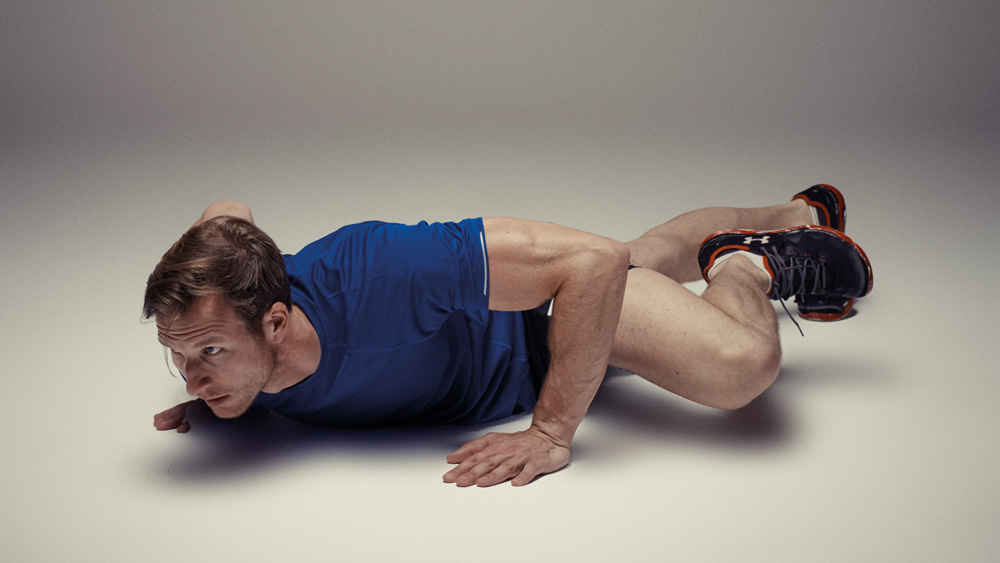
This heroic variation is a move that’s not just about the chest, shoulders and triceps. Your upper and lower abs need to be fully engaged to draw one knee up to your elbow then back down again, and you’ll activate the deep stabilizing muscles of your core to keep your whole body stable throughout each rep. It’s a hard move, but mastering it will mean better performance and a better physique. Keeping your torso level with the floor, as opposed to rotating as you raise your knee, will keep the maximum amount of tension in your abs.
- Start with your hands underneath your shoulders and toes on the floor.
- Brace your core and raise your hips so your body forms a straight line from head to heels.
- Keeping your weight on your arms, bend your elbows to lower your chest towards the floor.
- As you lower, draw one knee up towards your elbow.
- Pause briefly at the bottom, with your chest as close to the floor as possible without touching it.
- Press back up powerfully to return to the start, straightening your leg as you do, then repeat with your other knee and alternate with each rep.
“The first thing to do to perform this move more efficiently and effectively is to engage your core before starting a set,” says Lerwill. “Do this by pulling in your bellybutton to tense your entire abs and deep core region. Bracing your midsection to keep it strong and stable—and focusing on keeping it tensed—will allow you to draw your knee all the way up while keeping your push-up form perfect to maximise your results.”
Dive-Bomb Push-Up
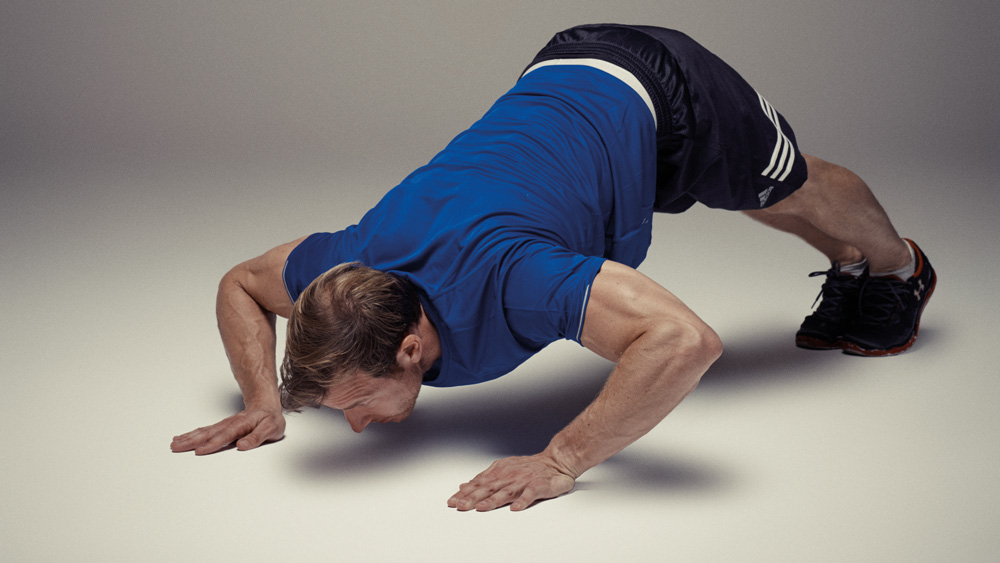
The very nature of this move means that for the duration of each rep there are a lot of different muscles fully engaged and under tension, which can only be a good thing when you want bigger, stronger and more defined muscles. The down-and-forwards then up-and-backwards movement also makes your chest, shoulders, triceps and core all work in different and more challenging ways from the standard push-up.
- Start with your hands and feet flat on the floor so that your body forms an inverted V-shape.
- Brace your core then lower your head and chest towards your hands, moving your torso and head forwards in a smooth arc as your head approaches the ground.
- Keep moving your upper body forward in a smooth arc until your eyes are looking forward and your chest is up.
- From there, raise your hips to return to the start position.
- Despite the aggressive-sounding name, the key to this exercise is maintaining a smooth movement path—the whole rep should be fluid and performed at an even tempo.
“Don’t worry about completing too many reps of this per set—instead, think about the muscles working at each point of the rep to build a stronger mind-to-muscle connection that will help you train more effectively in every session,” says Lerwill. “The nature of this movement means some areas will be far more difficult than others, with the most likely sticking points coming when your shoulders or triceps are fatigued but your chest is still strong. If that happens, do this variation to failure, then go straight into regular or wide-arm push-ups to keep working the chest muscles with a slow and controlled tempo for faster gains.”
Fingertip Push-Up
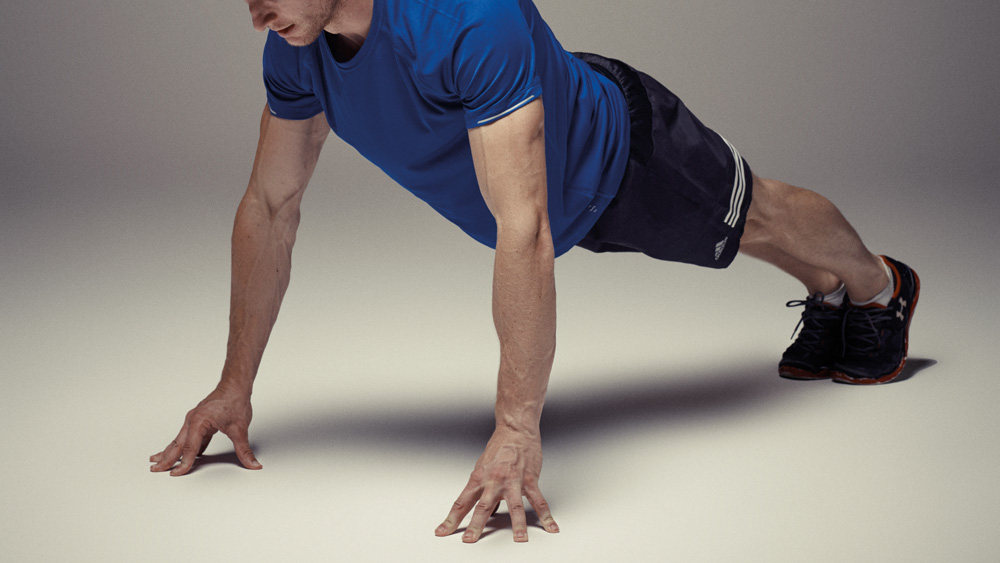
This variation is more about your finger and wrist strength than upper-body strength, so it’s best suited to people who want or need stronger fingers and wrists, such as MMA fighters, climbers and gymnasts. If that’s not you but you’re still up for a really big challenge, then give it a go—but don’t get disheartened when you fail! As with anything worthwhile, it takes time and effort to get good at this move, so add one or two reps per session over the weeks and months to build finger strength slowly without risking injury. If you’re unable to perform a rep on your fingertips, you can still develop finger and wrist strength by holding the top position for as long as possible.
- Start with your hands underneath your shoulders but with just your fingertips in contact with the floor.
- Brace your core and raise your hips so your body forms a straight line from head to heels.
- Keeping your weight on your arms, bend your elbows to lower your chest towards the floor.
- Pause briefly at the bottom, with your chest as close to the floor as possible without touching it.
- Press back up powerfully to return to the start.
“It’s worth experimenting with different finger positions,” said Lerwill. “We are all anatomically different, so some people find the exercise easier with fingers spread, others with fingers quite close, some somewhere in the middle. It all depends on finger length, size of hands, arm length and many other factors. If you’ve mastered one way, then try another—there are many ways to adapt and progress with an exercise, so don’t be afraid to use your imagination and experiment. Maybe one day you’ll be able to do a dive-bomb push-up on your fingertips!”
About Our Experts
Sean Lerwill is a former Royal Marine physical training instructor. He has a written a number of Haynes manuals, including Royal Marines Fitness, and as a fitness model has appeared on the cover of Men’s Fitness in the UK and Australia. He works as a trainer and coach at boutique London studio The Third Space.

Alasdair Nicoll is a personal trainer tutor and assessor at The Fitness Group, which provides personal training courses, and a level 3 personal trainer himself. Nicoll has been a personal trainer since 2018 and also has a BSc in Food Bioscience from Glasgow Caledonian University.
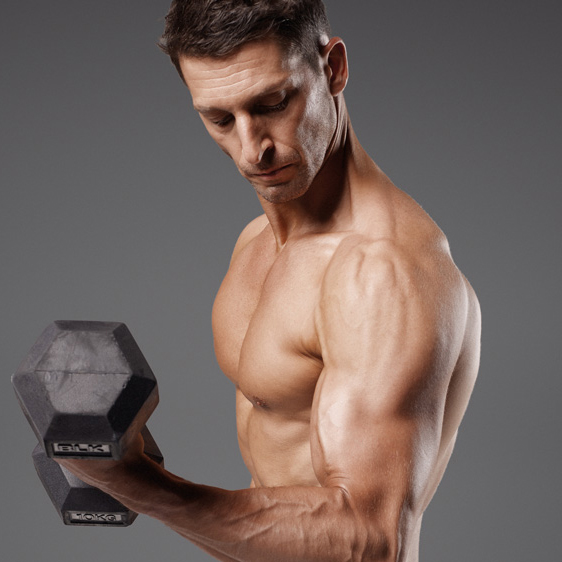
Joe Warner is a highly experienced journalist and editor who began working in fitness media in 2008. He has featured on the cover of Men’s Fitness UK twice and has co-authored Amazon best-sellers including 12-Week Body Plan. He was the editor of Men’s Fitness UK magazine between 2016 and 2019, when that title shared a website with Coach.
- Nick Harris-FrySenior writer









